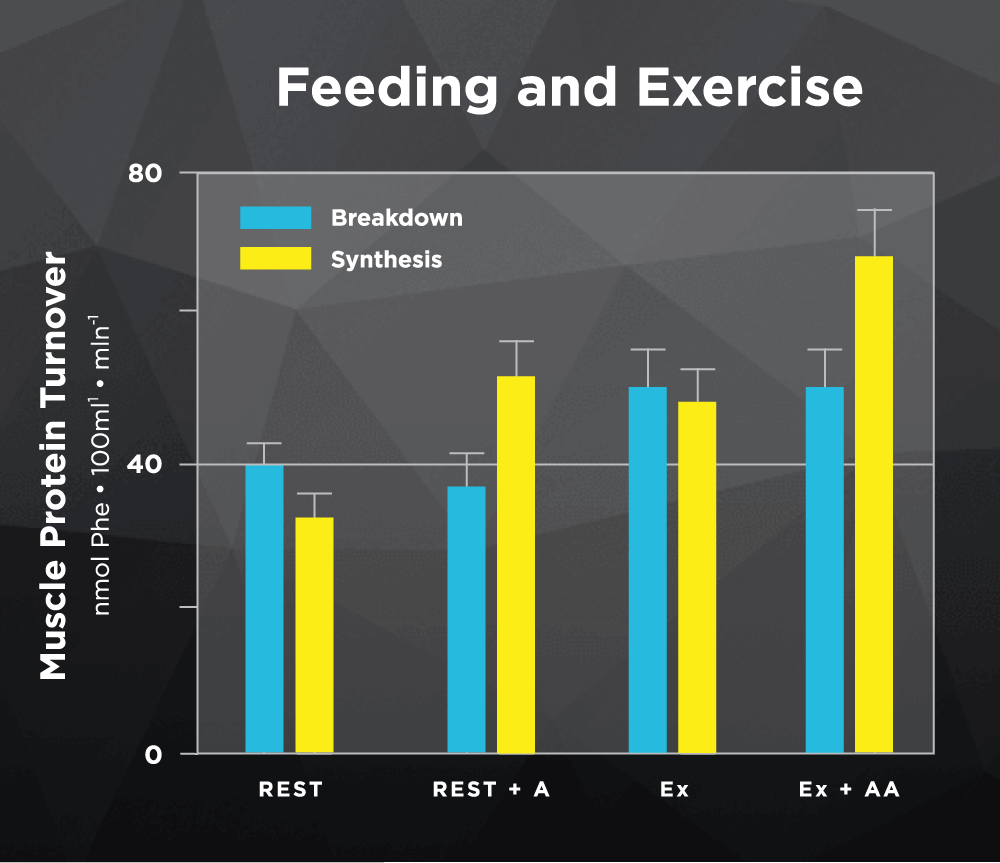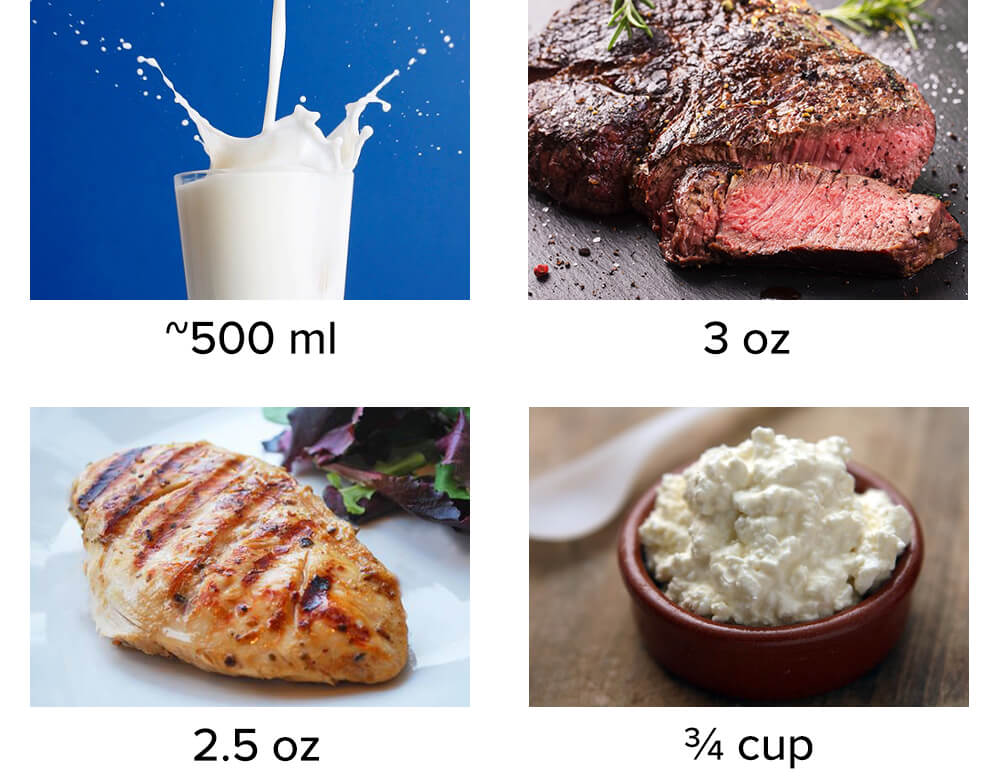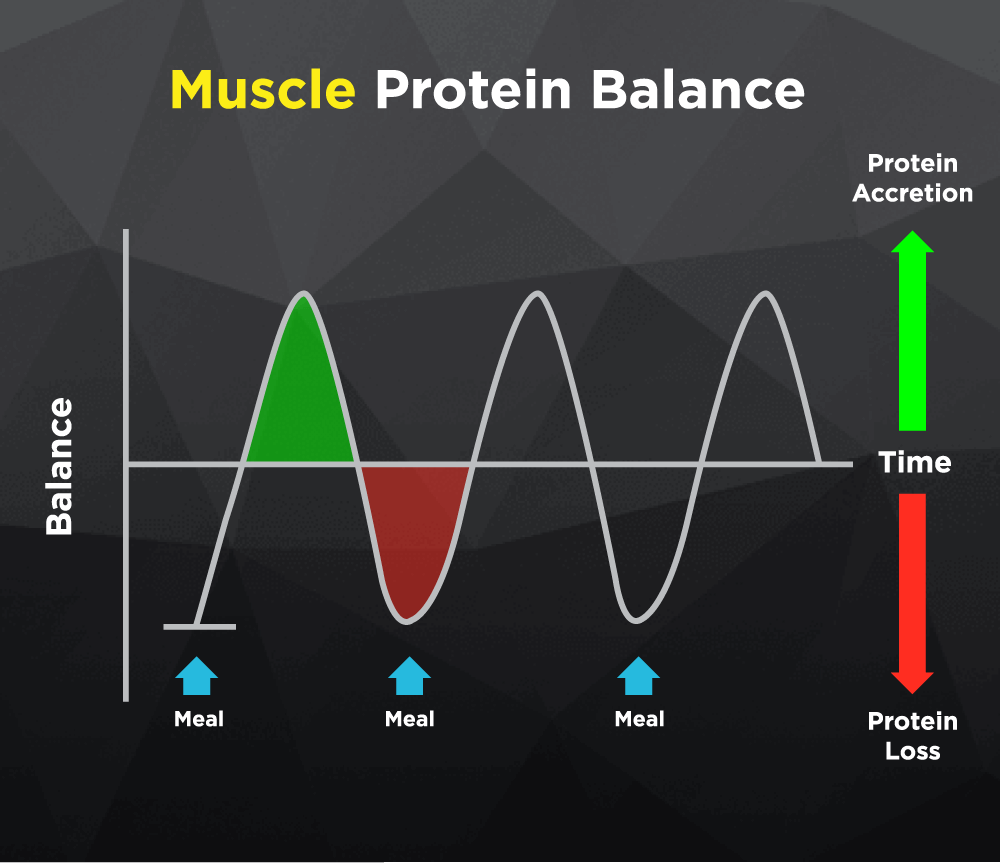Although resistance exercise (RE) alone is inherently anabolic (increases Muscle Protein Synthesis, MPS), we require protein and its constituent amino acids (AAs) to adequately facilitate the repair and remodeling of skeletal muscle cells in response to exercise.
Ultimately we’re interested specifically in muscle hypertrophy, but acute measures offer a useful indicator of long-term phenotypic potential [1]. Acutely, the skeletal muscle adaptive response is often characterized by the balance between anabolic (Muscle Protein Synthesis, MPS) and catabolic (Muscle Protein Breakdown, MPB) reactions in muscle. When the aggregated effect of MPS exceeds MPB we’re in a Positive Net Protein Balance (NPB); creating a requisite environment for protein accretion. In order to augment this positive balance, conceptually increasing muscle growth, one can leverage the effects of amino acid ingestion and resistance exercise to drive the cascade of physiologic adaptations (as depicted in image below).

Skeletal muscle hypertrophy (growth) occurs when these aggregated acute anabolic and catabolic reactions result in a positive net protein balance over time. Although RE alone will augment MPS, breakdown is correspondingly increased, thus requiring nutrients (Amino Acids, AAs) to realize a positive protein balance [2]. Post-exercise, the muscle cell is primed for nutrient intake – providing specific AAs (particularly Leucine) in sufficient quantity during this post exercise period comprises an essential role in the adaptive process. Notably, leucine has a unique capability to provide the impetus or instruction to build new proteins (signaling) and the substrate to carry it out (Muscle Protein Synthesis) [2][3][4].
Take Home: If optimizing the acute anabolic environment is the primary objective, protein intake during the post workout period should meet a minimum threshold of ~20g (.25g/kg/bw/meal) and comprised of a strong amino acid profile, specifically high in leucine (~ 2.5g) and the supportive essential amino acids. Any Whey protein supplement would sufficiently provide these characteristics in one serving. Importantly, whole foods contain a uniquely valuable nutrient-rich food matrix with micronutrient factors that may influence other parameters of health [5]. For individuals that would prefer a steak, eggs or milk to the conventional protein supplement, you are still in good hands. In order to hit these minimum thresholds, any of the following would suffice:

What is the ‘Post Workout Period’?
Having established the type of protein required to optimize the acute skeletal muscle adaptive response post workout, it’s important we define this evidently critical period. Often described by supplement brands, gyms and lay publications around the world, is the idea of the post workout period being a brief 30 – 120-minute phase providing the infamous “anabolic window of opportunity”. This implies that any protein supplementation (whole food or isolated) must be consumed within this timeframe to optimize the response and immediately offset any catabolic processes. The rationale behind this idea is somewhat sound, in that resistance exercise is causing a sensitization to AAs ingested subsequent to the exercise bout. In other words, exercise sets the stage to maximally use AAs for building new proteins (i.e. muscle). However, this environment that is particularly primed for amino acid supply (exogenous protein) appears to be maintained for much longer than conventional ‘broscience’ might recommend – the scientific literature proposes at least 24 hours [6]. Clearly, this evidence provides insight into the flexibility we have to adequately facilitate the repair and remodeling of muscle in a full day following an individual exercise bout.
Take Home: Post workout nutrition is essential to the repair and remodeling of skeletal muscle in response to exercise. Physiologic reactions in muscle that result from RE, create an environment that uniquely facilitates this adaptive process by utilizing AAs to support anabolism. This sensitization of the muscle persists for at least 24 hours in some cases, indicating an extended ‘window of opportunity’. Individuals whom consume relatively high protein diets habitually, can carry out their normal eating patterns without modifying the timing or distribution, while still sufficiently meeting any threshold to optimize anabolism.
To further clarify the synergistic effect of RE and protein ingestion, the graph below describes the normal cyclical pattern of muscle protein accretion and loss throughout the day absent of an exercise stimulus (figure on the left). As you can see, each meal consumed causes a subsequent rise in protein accretion to a peak well above ‘balance’ (0), then returns to a loss during the extended postprandial phase. Ultimately resulting in a Zero Net Protein Balance for the day, theoretically meaning no protein accretion took place, or we ‘broke even’. Conversely on the right, when we start the observation period with RE, an attenuation of protein loss prior to feeding occurs, followed by a superior peak in protein accretion after ingestion. Importantly, notice what happens in each subsequent meal throughout the day; we maintain a similar synergistic effect from the RE bout that was performed in the beginning. Eventually these marginal benefits gradually subside, seemingly in perfect timing for the next exercise bout the following day. To be clear, RE does not reduce protein breakdown, it actually increases it, but RE & AA ingestion stimulates muscle protein synthesis to a greater extent. The summation of the effects graphically depicted below result in a positive net protein balance, and consequently protein accretion.


Conclusion
Individuals trying to maximize the skeletal muscle adaptations to training with protein ingestion, should focus on determining and implementing the following:
- Daily protein requirements: 1.6 – 2.4 g / kg or .24g/kg/meal [7] (these estimates are for young healthy people, elderly would require more, ~.40g/kg/meal)
- Feeding pattern: identify a feeding strategy that fits consistently within your lifestyle. You do NOT have to adhere to this always, as long as you generally achieve your daily protein requirements.
- Protein quality: Focus on individual or combinations of protein sources that meet critical thresholds of leucine (~2.5g) with a supporting cast of essential amino acids. Identify supplement & whole food options that are consistent with your preferences, health circumstances and ethically driven dietary decisions.
Notably, VEGETARIANS can still achieve all of the above by using a combination of high quality protein plant sources. Whatever your dietary or lifestyle circumstances, intelligently select your approach to optimize consistency, adherence and enjoyment of the process designed to achieve it. What science continues to point toward, is the capacity individuals have to personalize their approach in an effort to maintain flexibility in programming characteristics that drive sustainability.
References
- Mitchell, C.J., et al., Acute post-exercise myofibrillar protein synthesis is not correlated with resistance training-induced muscle hypertrophy in young men. PLoS One., 2014. 9(2): p. e89431. doi: 10.1371/journal.pone.0089431. eCollection 2014.
- Churchward-Venne, T.A., et al., Leucine supplementation of a low-protein mixed macronutrient beverage enhances myofibrillar protein synthesis in young men: a double-blind, randomized trial. Am J Clin Nutr., 2014. 99(2): p. 276-86. doi: 10.3945/ajcn.113.068775. Epub 2013 Nov 27.
- Burd, N.A., et al., Greater stimulation of myofibrillar protein synthesis with ingestion of whey protein isolate v. micellar casein at rest and after resistance exercise in elderly men. Br J Nutr., 2012. 108(6): p. 958-62. doi: 10.1017/S0007114511006271. Epub 2012 Jan 31.
- Apro, W., et al., Leucine does not affect mechanistic target of rapamycin complex 1 assembly but is required for maximal ribosomal protein s6 kinase 1 activity in human skeletal muscle following resistance exercise. FASEB J., 2015. 29(10): p. 4358-73. doi: 10.1096/fj.15-273474. Epub 2015 Jul 13.
- Baier, S.R., et al., MicroRNAs are absorbed in biologically meaningful amounts from nutritionally relevant doses of cow milk and affect gene expression in peripheral blood mononuclear cells, HEK-293 kidney cell cultures, and mouse livers. J Nutr., 2014. 144(10): p. 1495-500. doi: 10.3945/jn.114.196436. Epub 2014 Aug 13.
- Burd, N.A., et al., Enhanced amino acid sensitivity of myofibrillar protein synthesis persists for up to 24 h after resistance exercise in young men. J Nutr., 2011. 141(4): p. 568-73. doi: 10.3945/jn.110.135038. Epub 2011 Feb 2.
- Moore, D.R., et al., Protein Ingestion to Stimulate Myofibrillar Protein Synthesis Requires Greater Relative Protein Intakes in Healthy Older Versus Younger Men. Journals of Gerontology Series a-Biological Sciences and Medical Sciences, 2015. 70(1): p. 57-62.

